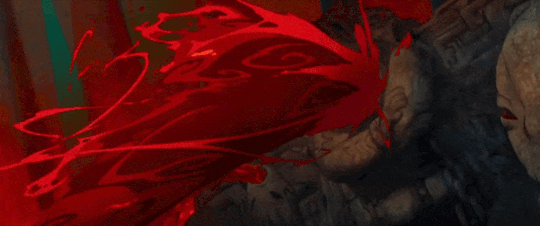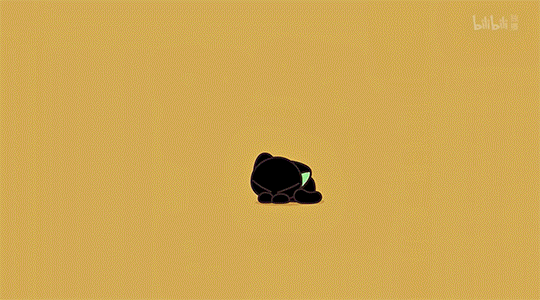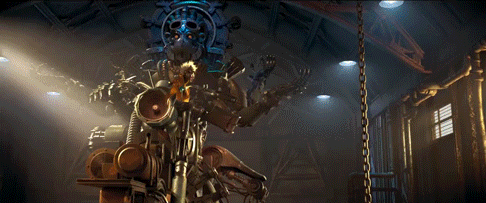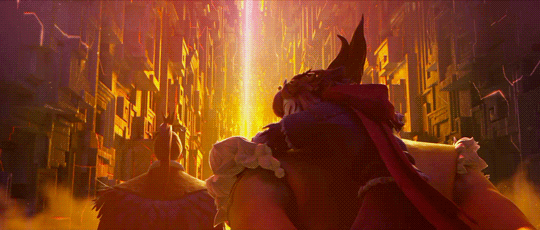originally posted at https://canmom.tumblr.com/post/682420...
Once again, 嘿朋友动画的晚上正在上映电影!
Tonight, Animation Night returns to China, where we’ve been on two previous occasions (27 and 46)…

I went into a great deal of detail in those previous posts, but just in case, here’s the key points of the story…
In the early years of the PRC, Chinese animation thrived under the state-backed Shanghai Animation Film Studio (上海美术电影制片厂), with highlights including the incredible ink wash films of Te Wei. Since then I’ve come across a lot of very interesting detail on how Te Wei’s films were made thanks to Animation Obsessive - the subtle gradients coming from an absolutely mad process of stacking up layers of semitransparent cels.
During the Cultural Revolution, such works were deemed politically suspect, and many of the animators sent to the countryside to do hard labour; animation continued to be used but only for heavy-handed propaganda films with little artistic ambition. After the CR ended, there was another ‘golden age’ as those old-school animators returned to Shanghai Animation Film Studio (c.f. this article), but there were few new voices entering the medium or being trained in their methods. Instead, as China was integrated into the circuit of global capitalism, Chinese animators would end up mostly working as cheap outsourced labour for foreign cartoons; the younger generation instead grew up watching anime, which would end up heavily influencing the resurgence in the 2000s.

The result of all this, Animation Obsessive relates in another (unfortunately paywalled) article, is a sort of weird complex about when guómàn (国漫) [Chinese domestic animation] will rise to match the level of animation in Japan and America. (That term has an interesting etymology incidentally - it’s a contraction of guochan dongman, with dongman itself a contraction of donghua manhua meaning comics and animation.) So while, as we’ve seen, Chinese animation, 2D and 3D, is often full of really quite astonishing technical feats and some tremendously moving films like Da Hu Fa, Chinese critics are often harshly critical of the high-profile projects:
The film is solid, and ambitiously crafted. But China’s press often excoriated Big Fish & Begonia — “many Chinese reviewers called its story unfocused and its cast of 100+ characters confusing,” Cartoon Brew reported. The directors themselves said that the film contained “a lot of shortcomings,” and that their “creative skills [were] still far from perfect.” Even its sizable profit was seen by critics as a disappointment.3
(…)
In China, that vision of Chinese animation as weak, lagging and inferior holds a powerful sway. Nezha was a smash hit, commentators admitted, but what about the rest of the animation scene? And wasn’t Nezha itself flawed? (It is.) Even as Nezha burned up the charts, one Chinese business analyst was talking about how future films could improve on it. “Its script is still a bit weak,” he said, before jumping into more criticisms.
The same anxieties can be seen echoed in the few English-language videos on donghua, such as that of Accented Cinema which I quoted in a previous article:
All of this may go some way to explain why Chinese animated films, 2D and 3D, often seem to putting in a great deal of effort to show off… which means that when animation nerds from other countries catch on to the sakuga treasure that’s been flying under our radars the reaction is often outright awe thanks to these visuals. (Even making reaction videos to that effect.)
imo, most significant source of promise may not be the massive amount of capital being invested into movies like Ne Zha and its sequel Jiang Ziya (Legend of Deification), which we’re gonna watch tonight, but the very busy ecosystem of flash animation and manhua that feeds it, along with the smaller studios like Nice Boat and Wolf Smoke who punch well above their weight. To quote another passage of AniObsessive:
Big Fish & Begonia started as a seven-minute Flash cartoon in 2004, which the directors fought for over a decade to turn into a feature film. It came from China’s renowned Flash animation scene in the 2000s. The Legend of Hei (2019), a commercial success that wowed Japanese critics, also began life as a Flash short.
Coursing through guoman is the scrappy spirit of Chinese Flash animation. Even Zhou Fangyuan, the rising young animator we interviewed last year, has said that her love for animation stemmed from seeing Bu Hua’s Flash cartoon Cat (2002) as a child.4
One thing you notice when watching something like Nice Boat’s Fog Hill of Five Elements is the fact that in between the mindblowingly spectacular fight sequences, the more comedic scenes throw in weibo meme faces and allusions like that; it’s in an immediate dialogue with that broader online fanbase.
[Incidentally, I think something similar is true for anime; the doujin scene cultivates a steady flow of new people who might be inclined to create manga and gives them a low pressure environment to practice and figure out their voice, and the art form of manga and anime both is widely enjoyed by a huge cross-section of society. Such a volume of creation pushes people to explore wider corners of the aesthetic space, and the to-and-fro interaction of people launching small variants and genre critiques acts as another engine to find our way into saying things we never could otherwise. The science fiction writer Theodore Sturgeon infamously declared ‘90% of science fiction is crap’ because 90% of everything is, but it is because of the 90% of crap that the 10% of ‘good’, however you define it, is even possible.]

What makes Chinese animation exciting then isn’t just the astonishing technical skill that’s so often on display, but a chance to tap into a separate tradition/ecosystem of animation-making with all its own weirdnesses and quirks - another plain on that huge aesthetic landscape. I definitely want to highlight specific studios and artists more as more work gets translated, but tonight the three films I have are all from different houses so we’ll theme it this way.
Unfortunately the demon at the heels of all these rosy statements is always capitalism:
From a practical standpoint, it’s true that the rise of guoman hasn’t happened yet. In 2018, around 80% of Chinese animation studios were in the red. The head of Chinese streamer Bilibili has famously admitted that most Chinese animation isn’t making money, despite how much appears each year. (“Government subsidies are one of the larger sources of income for animation companies,” noted one outlet in 2020.)
This isn’t really unusual. In Japan, from capitalism’s perspective, animation is made not for the sake of direct profit from bluray sales and similar, but to create a psychic force to promote more profitable industries such as the source manga or merch such as toys. The balance of power is heavily in favour of capital against labour, protected by mechanisms like the production committee system. In Europe, animated films usually have the backing of multiple governments’ film boards, and target the film festival circuit. Even in America, a few unsuccessful films can be made grounds to do away with traditional animation entirely. Animation is weirdly an art form that could never have arisen before capitalism, yet the need to be profitable remains a massive barrier to its potential.
I always have more to say about that, but let’s not try and armchair general a way to divert a decent portion of the surplus of social production into art-making, without creating barriers like paywalls which slow the dissemination and cross-pollination of culture, right now. Instead, ahem, what films are we to watch?

First up, we have Jiang Ziya (姜子牙) or Legend of Deification, the direct sequel to the charming Ne Zha we watched back on Night 46, produced by Beijing Enlight Pictures. The goal of this massive project seems to be to create a sort of ‘cinematic universe’ based on the Investiture of the Gods, not simply retelling it but fleshing out the classical story with more modern characterisation and new character arcs. While the first film told the story of the bratty childhood of superpowered Nezha, this one follows (who else?) Jiang Ziya, a nobleman who helped secure the rise of the Zhou dynasty. Here’s how he enters Investiture, as summarised by Wikipedia:
Jiang Ziya is an apprentice of master of the Kunlun Mountains Yuanshi Tianzun. He leaves his master at the age of 72. He only uses a straight fishhook without bait, three feet above the water, for angling. His neighbours are puzzled by his odd method of fishing. They ask him out of curiosity. Jiang replies, “What I’m angling is not a single fish, but the king and the great many vassals. Only those who really wish to go on the hook will be fished by me.” Jiang Ziya means that he is waiting for a wise ruler who recognises his talent and needs him.
Some people tell Ji Chang about Jiang and Ji Chang becomes interested in him. One day, Ji Chang pays a visit to Jiang Ziya. Jiang demands that the duke helps him pull his cart. Ji Chang does so and stops pulling after he has moved 800 steps forwards. Jiang Ziya tells the duke that his future kingdom (the Zhou dynasty) will exist for 800 years. Ji Chang wishes to pull the cart for a few more steps but he is too exhausted to move forward. Jiang Ziya becomes the chancellor of Zhou afterwards and assists Ji Chang in building his kingdom.
In this film, Jiang Ziya - now a war hero - is dispensed to kill the Nine-Tailed Fox spirit, but hesitates when the Fox reveals that she has a young girl inside her - for which he is punished by banishment. In exile, the girl returns, and the pair get pulled into some nasty heavenly intrigue; I won’t spoil how it ends but it sounds pretty sick.

New Gods: Nezha Reborn (新神榜:哪吒重生) by Light Chaser Animation Studios offers a completely different, cyberpunk take on the Nezha story; Nezha is reincarnated 3000 years later in a cyberpunk city styled after 1920s Shanghai, and gets drawn into a gang war. Its approach to CG stylisation calls to mind the Lupin III CG film to me, though I don’t know if that’s a fair comparison lol. It’s received a ton of praise for strong direction and inventive action choreography, and AniObsessive name it as their favourite of the recent Chinese animated films… but the story details I have are relatively scant.

And if that sounds like an overload of CG spectacle, The Legend of Hei (罗小黑战记) presents a different dimension. Originally a successful series of web flash animations that became wildly popular on Bilibili with cute cat designs alongside well-choreographed martial arts (first episode translated here), in 2019 it got a feature-length prequel which became an international success. The series opens with a mother and daughter adopting a small black cat, only for it to gradually become evident that it has supernatural powers; when the girl kisses its head it abruptly turns into Ghibli’s Howl, explaining that the cat is actually a cursed prince.
I was really excited to watch all there of these films, but unfortunately I’m still waiting for any of them to finish downloading; with a bit of luck I should have one in the next hour. So Animation Night 102 will begin at like 10pm >< and continue tomorrow evening. Apologies for not being more organised about this - please look out for the announcement when it’s time!
A few words about New Gods after having seen it: what a fascinating movie! Spectacular set design and an absolutely unabashed indulgence in over the top design that made it feel very akin to something like Final Fantasy VII. Despite the long runtime, it rushed through familiar plot beats at a breakneck pace (it certainly helped a lot to have seen other adaptations of Nezha’s story), with the first quiet drama scene coming more than an hour in, but it had such a strong sense of fight choreography that this breathless approach totally worked in the end. Then it went so far as to drop three entire mid/post-credits scenes like a parody of a Marvel movie which, I don’t know if it was intended as a joke, but the sheer audacity really got me.
The character animation was interesting to me. A lot of modern CG films aim for a pretty naturalistic sense of acting, often fed by mocap, but here the characters took on pretty exaggerated poses all the time and almost always moved very quickly so that every scene was brimming with liveliness. In some ways it certainly reminded me of CG student animation, but this wasn’t a bad thing, just an element of the film’s whole cadence to get used to. Overall it had a curious mix of feeling very confident and technically accomplished in many different fronts, and yet still like it had a lot to prove. In a way it felt like what RWBY aspires to be. But, compared to American CG films of late, it generally felt a lot more fun and ‘like a human made it’.
I’m definitely keen to watch more of Light Chaser’s works, we’ll try and put the White Snake duology on in a few weeks time.
Anyway, come back to https://twitch.tv/canmom at 7pm UK time for two more films! Looking forward to showing you!
Comments